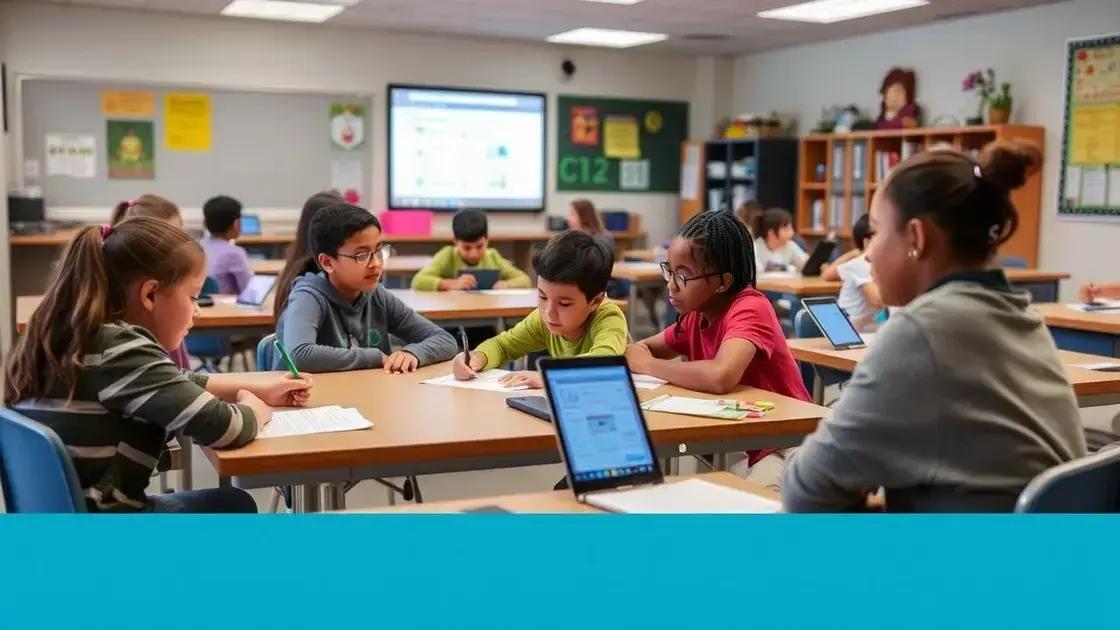Digital transformation in education: is your school ready?

Anúncios
Digital transformation in education integrates technology into teaching and learning, enhancing personalized experiences, improving communication, and fostering collaboration among students and educators.
Digital transformation in education is reshaping how students and teachers interact in the learning environment. Have you ever wondered how technology influences modern classrooms? Let’s dive into this fascinating topic.
Anúncios
Understanding digital transformation in education
Understanding digital transformation in education is essential for creating modern learning environments. This shift not only changes how information is delivered but also how students engage with it. Technology has drastically altered the landscape of education, paving the way for innovative practices and enhanced learning experiences.
What is Digital Transformation?
Digital transformation refers to the integration of technology into all areas of education, leading to fundamental changes in how schools operate. It involves using digital tools to improve teaching methods and administrative processes. With this transformation, the focus shifts from traditional methods to student-centered approaches that facilitate collaboration and interactive learning.
Key Components of Digital Transformation
- Technology Integration: Incorporating devices and platforms into everyday learning.
- Personalized Learning: Tailoring education to meet individual student needs.
- Collaboration Tools: Utilizing software that allows students and teachers to connect and work together.
- Data Analytics: Using data to inform decisions and improve student outcomes.
As educators embrace these technologies, it’s crucial that they receive proper training and support. Professional development can empower teachers to utilize these tools effectively. This leads to increased engagement and better educational outcomes. By fostering a culture of innovation, schools can enhance the learning experience.
Anúncios
Moreover, students today are digital natives. They are familiar with technology from a very young age and expect their educational experiences to reflect this familiarity. Therefore, incorporating digital transformation into education not only aligns with their expectations but also prepares them for the future workforce.
Challenges to Consider
While digital transformation presents numerous benefits, it also comes with challenges. Some of these challenges include:
- Budget Constraints: Many schools face limited funding for technology upgrades.
- Training Gaps: Teachers may need additional training to make full use of new technologies.
- Access Inequality: Ensuring all students have equal access to digital resources is essential.
In conclusion, understanding digital transformation in education involves recognizing its potential to reshape learning. By addressing challenges and harnessing technology effectively, educators can provide enriching experiences that equip students for success.
Benefits of digital transformation in schools
The benefits of digital transformation in schools are numerous and impactful. With the integration of technology, schools can enhance the educational experience for both students and teachers. Through digital tools, learning becomes more engaging and effective.
Enhanced Learning Experience
One of the key advantages is the ability to provide an interactive learning environment. Students can access a wealth of online resources that cater to various learning styles. This means that visual learners can use videos, while those who prefer reading can find e-books and articles. Personalized learning paths become more achievable.
Improved Communication
Another significant benefit is enhanced communication between teachers, students, and parents. Digital platforms allow for seamless sharing of information. In addition, tools like learning management systems enable teachers to provide timely feedback. Here are a few aspects:
- Instant Messaging: Enables quick communication for questions and clarifications.
- Parent Portals: Keep parents informed about their child’s progress.
- Feedback Tools: Provide instant evaluations and performance insights.
This open line of communication fosters stronger relationships and community involvement. Furthermore, it ensures everyone is on the same page regarding educational goals.
Access to Resources
Digital transformation allows schools to expand their resources beyond traditional textbooks. Students can explore various platforms for research and learning, enriching their education. They can utilize digital libraries, online courses, and even guest lectures via video conferencing.
Additionally, adopting technology can prepare students for the future. Many careers today require familiarity with digital tools and platforms. By experiencing these technologies in school, students gain valuable skills that will help them in their future careers.
Increased Efficiency
Digital tools make administrative processes more efficient. Tasks such as grading, attendance tracking, and resource management become streamlined and less time-consuming. This allows teachers to focus more on their core responsibility: teaching. Furthermore, automation reduces the potential for errors and enhances overall productivity.
In summary, the benefits of digital transformation in schools include improved learning experiences, better communication, broader access to resources, and increased efficiency. These advantages contribute to a more dynamic and responsive educational system, equipping students for success in a digital world.
Key technologies driving change in education

The key technologies driving change in education are reshaping how we teach and learn. These tools not only enhance the quality of education but also make learning more accessible. Understanding these technologies is crucial for educators and students alike.
Learning Management Systems (LMS)
Learning Management Systems, or LMS, are essential platforms that help manage online learning. They allow teachers to organize courses, share materials, and track student progress. An LMS provides a centralized location for resources and communication.
Interactive Learning Tools
Interactive learning tools, such as digital whiteboards and educational software, engage students in an immersive way. These tools make lessons more relatable and fun. Examples include:
- Quiz platforms: Increase student engagement through gamified learning.
- Simulation software: Offers hands-on practice in a virtual environment.
- Augmented Reality (AR): Brings subjects to life by overlaying digital content onto the real world.
These technologies create a dynamic classroom experience, making learning more effective.
Artificial Intelligence (AI)
Artificial Intelligence is becoming increasingly important in education. It can provide personalized learning experiences by adapting resources to meet individual student needs. For instance, AI-powered tutoring systems can analyze student performance and offer targeted feedback. This allows students to learn at their own pace.
Cloud Computing
Cloud computing is another technology that facilitates collaboration and access to resources. With cloud storage, students and teachers can easily share documents and work together on projects from any location. This flexibility supports group work and enhances communication.
Furthermore, cloud computing makes it possible to access educational materials anytime, anywhere. Students can retrieve lessons or assignments outside school hours, promoting continuous learning.
Data Analytics
Data analytics plays a critical role in understanding student performance. By collecting and analyzing data, schools can identify trends and areas where students may need additional support. This informed approach helps educators make data-driven decisions to improve teaching strategies.
Overall, the key technologies driving change in education include learning management systems, interactive tools, artificial intelligence, cloud computing, and data analytics. These technologies are not just trends; they are transforming how education is delivered and experienced.
Overcoming challenges in educational technology
Overcoming challenges in educational technology is essential for achieving successful digital transformation in schools. While technology can enhance learning, various obstacles can hinder its implementation. Addressing these issues allows for more effective use of technologies in education.
Resistance to Change
One of the main challenges is the resistance to change among educators and staff. Adopting new technologies can seem daunting, especially for those accustomed to traditional methods. Training and support are vital in easing this transition.
Lack of Funding
Another significant barrier is the lack of funding for new technologies. Schools often operate on tight budgets, making it difficult to invest in the latest tools. To overcome this, it’s essential to explore alternative funding options:
- Grants: Many organizations offer grants for educational technology initiatives.
- Partnerships: Collaborate with local businesses that may provide resources or funding.
- Community Support: Engage the community to help raise funds for technological upgrades.
Securing adequate resources can dramatically influence the implementation of educational technology.
Training and Professional Development
Effective training is crucial for overcoming challenges in educational technology. Without proper training, educators may struggle to utilize tools effectively. Ongoing professional development can ensure that teachers are equipped to integrate technology into their classrooms.
Access to Technology
Access to technology can also pose a challenge. Not all students have the same access to devices or reliable internet. Schools need to develop solutions to provide equitable access:
- Device Lending Programs: Offering devices for students to use at home can help bridge the gap.
- Community Wi-Fi: Establishing free Wi-Fi zones in communities can support students’ connectivity.
- Hybrid Learning Options: Incorporating both in-person and online learning can accommodate different needs.
Ensuring that all students can participate in digital learning is key to overcoming access barriers.
Staying Updated with Technology
Technology is constantly evolving, so staying updated can be challenging. Regular evaluations of existing tools and training on emerging technologies can help educators keep pace. Ensuring that both teachers and students are well-informed is essential for maximizing the benefits of educational technology.
By actively addressing these challenges, schools can successfully integrate technology into the learning process. This transformation not only enhances the educational experience but also prepares students for a technology-driven future.
Future trends in digital education
Future trends in digital education promise to transform how students learn and interact with educational content. As technology advances, schools must adapt to ensure that they provide relevant and effective learning experiences.
Personalized Learning Experiences
One significant trend is the shift towards personalized learning. With the help of data analytics and artificial intelligence, educators can tailor lessons to meet the individual needs of each student. This approach helps identify strengths and weaknesses, making learning more effective.
Blended Learning Models
Blended learning is another trend that combines traditional classroom teaching with online instruction. This method offers flexibility and allows students to learn at their own pace. Key components of blended learning include:
- Synchronous Learning: Online classes that happen in real-time.
- Asynchronous Learning: Access to pre-recorded lessons that students can view according to their schedule.
- Face-to-Face Interaction: Regular in-person sessions to reinforce online learning.
Blended learning environments support diverse learning styles and empower students with control over their education.
Increased Use of AR and VR
Another exciting trend is the increased use of augmented reality (AR) and virtual reality (VR). These technologies provide immersive learning experiences, enhancing engagement and understanding. For example, students can take virtual field trips or interact with 3D models in science lessons. This technology creates realistic simulations, allowing for deeper exploration of complex subjects.
Global Learning Communities
The future of education will also see the growth of global learning communities. Online platforms enable students from different parts of the world to collaborate on projects. This exposure fosters cultural awareness and enhances communication skills, preparing students for a globalized career landscape.
Focus on Lifelong Learning
As job markets evolve, the need for lifelong learning becomes critical. Digital education will emphasize continuous skill development beyond traditional schooling. Resources like online courses, webinars, and workshops will play a significant role in this process. This focus ensures that learners remain competitive and adaptable in their careers.
Moreover, with advancements in technology, we can expect more engaging and interactive content in the future of digital education. Overall, staying informed about these trends will help educators and institutions effectively prepare for the changes ahead.
FAQ – Frequently Asked Questions about Digital Transformation in Education
What is digital transformation in education?
Digital transformation in education refers to the integration of technology into all aspects of teaching and learning, enhancing educational experiences.
How does personalized learning benefit students?
Personalized learning tailors education to meet individual student needs, allowing them to learn at their own pace and according to their interests.
What are the challenges of implementing educational technology?
Some challenges include resistance to change among educators, lack of funding, and ensuring equitable access to technology for all students.
How will augmented reality (AR) impact education?
AR will enhance education by providing immersive experiences that make learning more interactive and engaging, helping students better understand complex subjects.





